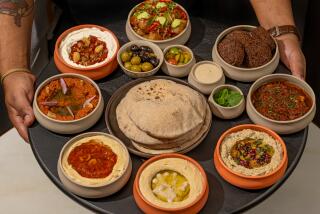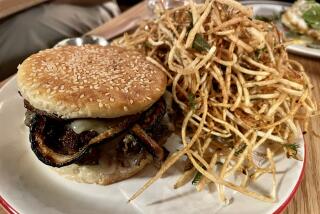The Meat of the Meatloaf
- Share via
There are a few things--mother love and meatloaf among them--that you should be able to enjoy without analysis. Unfortunately, life is rarely that simple.
With meatloaf, at least, the world is full of confusing and contradictory advice.
To be perfectly honest, meatloaf has never been something I’ve worried much about. The couple of times a year we have it, it’s usually my wife who makes it, from the recipe on the back of the oatmeal box. It’s made with beef and--what else?--oatmeal. And I’m always happy to have somebody else cook dinner.
But the other day I was in a meatloaf mood and had some time on my hands. I went to the bookshelf and pulled down every cookbook I could find with meatloaf recipes in it.
After analyzing a couple of dozen recipes, I found that few agreed on anything. Some loaves are all beef; some are all pork. Some are beef and pork. Some are beef, pork and veal. Some use ham and some use sausage meat. Some use four times as much beef as other meats; some use equal proportions.
Some are filled out with cracker crumbs, some with bread crumbs. Some, of course, use oatmeal. Some use several eggs, some only a few. Some are baked in loaf pans, some are free-form. One was even boiled.
What’s a cook to do?
In this case, I headed to the supermarket, filled my shopping cart with various ground meats and tiny loaf pans and headed home to cook.
Since the biggest differences among the recipes seemed to center on the most fundamental ingredients, that seemed to be the most logical place to start my experiments. You’ve got to know whether you’ll build your house of brick or straw before you decide how to decorate it.
The first thing I wanted to determine was what effect the type of meat had on a meatloaf. Meat, of course, is not just meat. Beef, pork and veal are very different from one another, not only in taste but also in physical composition.
So I made loaves ranging from all beef to equal parts beef, pork and veal, with many stops between. I added an equal amount of cracker crumbs and egg to each of the mini-loaves, then baked them.
I found that the all-beef meatloaf, while it was very, well, beefy in flavor, was extremely coarse and crumbly when compared to the others. The addition of pork seemed to smooth the texture but still left the loaf somewhat dry and crumbly. But adding ground veal made the best loaf: firm, compact and moist with a nice, round meat flavor--especially when mixed in the ratio of 2 parts beef to 1 part pork and 1 part veal.
The meatloaf made with equal parts beef, pork and veal had a nice texture, but the flavor was bland. Maybe you’d want to use it if you were going to add a lot of other flavors. Save it for that Asian-Cajun meatloaf you’ve been so anxious to try.
The different meat mixtures also reacted differently during cooking. To mark which loaf was which, I poked finger holes deep into the top of each loaf. When they were done cooking, the holes in the loaves with the most pork and veal in them were swollen practically shut. Fortunately, I had also drawn a little map of where each loaf had been placed on the sheet pan.
The amount of fat in the beef also makes a difference. A meatloaf made with the very lean, 7% fat ground beef was much crumblier than the others. On the other hand, the high-fat ground beef really gave up a lot of grease. The 15% fat beef made a meatloaf that was just right.
The next question was the amount--and type--of starch to use. The starch--cracker crumbs, bread crumbs or oatmeal--absorbs fat and water wrung out of the meats by cooking.
Using my new standard mix of ground meats, I added cracker crumbs in amounts ranging from a quarter of a cup to 1 cup per pound of meat. I also tried bread crumbs and oatmeal.
As you might expect, the 1-cup-per-pound loaves were pure cafeteria food--gummy in texture, tasting more like breading than like meat. As obvious as this may seem, it was still the ratio preferred by a surprising number of cookbooks.
When I cut that ratio in half, the result was much better--particularly with the cracker crumbs as the binder. Cut it in half again (1/4 cup per pound of meat) and the result was even better, with a smooth, slightly crumbly texture that was still nice and juicy.
At least that was true for the cracker and bread crumbs. The loaf made with oatmeal still had a very distinct oat flavor. Between crackers and bread, I preferred the crackers, but it was close. The difference might have been the additional salt in the crackers, which probably boosted the flavor a little.
Fortunately, I also found that meatloaf is very forgiving. I sliced half a dozen of the better loaves and took them to a dinner for my daughter’s swim team. Nobody complained. Even the worst of the loaves was fine for sandwiches (mayonnaise and maybe a little catsup). As you might have guessed, we ate a lot of those.
Like mother love, even an imperfect meatloaf is sustaining.
WILD MUSHROOM MEATLOAF
3 ounces dried wild mushrooms (preferably morels)
1 cup red wine
1 tablespoon olive oil
2 carrots, coarsely chopped
1 stalk celery, coarsely chopped
1 onion, coarsely chopped
1 clove garlic, minced
2 pounds ground beef (preferably 15% fat)
1 pound ground pork
1 pound ground veal
2 teaspoons fresh thyme
1 teaspoon minced fresh rosemary
2 eggs
1 cup cracker crumbs
1 tablespoon salt
Freshly ground black pepper
Simmer mushrooms and red wine in small saucepan over low heat until mushrooms soften, 15 to 20 minutes. When cool enough to handle, chop and set aside.
Heat oil in medium saute pan over high heat. When oil is very hot, add carrots. Cook, without stirring, 2 to 3 minutes, until carrots begin to darken. Toss and stir to prevent sticking and cook another 2 to 3 minutes. Reduce heat to medium and add celery. Stir and cook another 2 to 3 minutes. Add onion and stir and cook another 2 to 3 minutes. Finally, add garlic, stir and remove from heat.
In large mixing bowl, thoroughly mix beef, pork and veal, squeezing between fingers to make sure no chunks of meat remain. Add cooked vegetables, chopped morels, thyme and rosemary; stir well to combine. Add eggs and mix lightly but thoroughly by hand. Sprinkle in cracker crumbs and mix by hand until all crumbs are absorbed. Add salt and pepper to taste.
Form into rough loaf shape in shallow baking pan. Bake at 350 degrees until outside is browned and interior temperature reaches 150 degrees, about 1 1/2 hours. Remove from baking pan to platter. Slice and serve.
Makes about 10 to 12 servings.
Each of 10 servings contains about:
426 calories; 908 mg sodium; 151 mg cholesterol; 27 grams fat; 15 grams carbohydrates; 27 grams protein; 1.27 grams fiber.
More to Read
Eat your way across L.A.
Get our weekly Tasting Notes newsletter for reviews, news and more.
You may occasionally receive promotional content from the Los Angeles Times.










